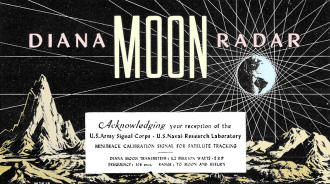|
Earth-Moon-Earth (EME)
communications have been used by amateur radio operators for a few decades now,
made possible by more capable transmitters and receivers as well as digital
encoding which facilitates operation closer to the noise floor. EME is regarded
largely as a novelty branch of Ham radio since relatively few people are set up
to exploit it. In 1946, the U.S. Army Signal Corps created "Project Diana," named for
the Roman moon goddess Diana, as an experimental exercise to bounce radar
signals off the Moon and receive the reflected signals. It was the first attempt
at radar astronomy and was the first time a terrestrial radio signal was bounced
off another celestial body. Once artificial satellites were orbiting in the late
1950's, Hams and other entities were encouraged to detect and track orbits and
signal transmission properties - including frequency and power - to aid
government engineers and scientists in determining stability (electrical and
mechanical), speed, rotation, altitude, path, atmospheric and cosmological noise
sources, and other parameters. In order to reward Hams for their efforts, QSL
cards were issued to anyone who took the trouble to report reception incidences. The
first QSL cards issued for satellite reception reports was by the Russians
during the
Sputnik flights in 1957.
Diana Moon Radar
 Amateur radio operators who successfully pick up signals from outer space
during calibration of the satellite-Minitrack stations can now show cards acknowledging
their reception. Before launching of U. S. satellites, the giant transmitter
and antenna of the Diana moon radar at the U.S. Army Signal Research and Development
Laboratory at Fort Monmouth bounce 108-mc. signals off the moon. This is done
so that the far-flung Minitrack stations and amateur radio operators can calibrate
their receivers for precise tuning to the transmitters aboard the U.S. satellites.
When hams receive the moon-bounced signals, they notify the Laboratory at Fort
Monmouth or the American Radio Relay League at West Hartford, Connecticut. In appreciation
of their assistance, the Army sends each reporting amateur a customary acknowledgement
or QSL card - the first one ever issued for picking up signals via the moon. Amateur radio operators who successfully pick up signals from outer space
during calibration of the satellite-Minitrack stations can now show cards acknowledging
their reception. Before launching of U. S. satellites, the giant transmitter
and antenna of the Diana moon radar at the U.S. Army Signal Research and Development
Laboratory at Fort Monmouth bounce 108-mc. signals off the moon. This is done
so that the far-flung Minitrack stations and amateur radio operators can calibrate
their receivers for precise tuning to the transmitters aboard the U.S. satellites.
When hams receive the moon-bounced signals, they notify the Laboratory at Fort
Monmouth or the American Radio Relay League at West Hartford, Connecticut. In appreciation
of their assistance, the Army sends each reporting amateur a customary acknowledgement
or QSL card - the first one ever issued for picking up signals via the moon.
Posted August 18, 2020
|










